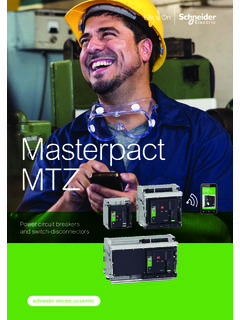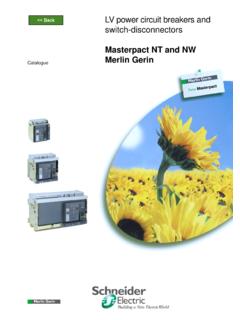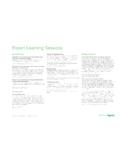Transcription of Earthing system - Schneider Electric - Extranet
1 Earthing systemHow to choose the right system Earthing arrangement?Application noteTechnical collection In order to ensure protection of persons and continuity of operation, the conductive wires and live parts of an electrical installation are "insulated" from the earthed exposed conductive involves:separation by insulating materialsseparation by linear clearances in gases ( in air) or by creepage distances along insulators ( to prevent flashover on electrical switchgear).Insulation is characterised by specific voltages which, in accordance with standards, apply to new products and equipment:insulation voltage (highest voltage on system )lightning impulse withstand voltage (1. /50 s impulse wave)power frequency withstand voltage ( U + 1000 V/1 min).Example for an LV switchboard of the Prisma type:insulation voltage: 1000 Vimpulse voltage: 1 commissioning a new installation, produced in accordance with standard working practices with products manufactured as per standards, the risk of an insulation fault is extremely low.
2 However, this risk increases with is because the installation is subjectedto a variety of aggressions which are responsible for insulation faults. Below are a few examples:during installation:ppppppppAll system Earthing Arrangements (SEA) provide equivalent protection of life and property. However each has certain advantages and inconveniences in other terms that may be important for a given , the three system Earthing arrangements, defined by standards IEC 60364 and NF C , are:the TN systemthe TT systemthe IT three systems have the same final purposeas regards protection of persons and equipment: control of insulation fault effects. They are considered as equivalent with respect to the pppprotection of persons against indirect same is not necessarily true for the dependability of the LV electrical installation regarding:availability of the electrical power supplymaintenance of the calculable parameters are becoming increasingly important in industrialand commercial of insulation faults mechanical deterioration of a cable insulatorduring operation: dust with a varying degree of conductivity the thermal ageing of insulators due to excessive temperature caused by.
3 - the climate- too many cables in a duct- an insufficiently ventilated cubicle- harmonics- the electrodynamic forces developed during a short-circuit which may damage a cable or reduce a clearance switching and lightning surges 50 Hz voltage surges caused by MV earth faults and affecting LV , it is a combination of these primary causes which results in an insulation fault can be either:a differential mode fault (between the live conductors) in which case it becomes a short-circuitor a common mode fault (between live conductors and the exposed conductive parts or earth). A fault current, referred to as a common mode or zero-sequence fault (MV), then flows in the protection conductor (PE) and/or in the Earthing arrangements in LV are mainly concerned by common mode faults which occur most frequently in loads and both commercial and industrial applications, needs change, and it is becoming increasingly important to choose the right system Earthing arrangement, according to rigorously defined working practices, in order to ensure the cohabitation of "high and low currents" and satisfy the operator s a review of the risks related to installation insulation faults affecting the safety of persons and equipment, this Technical Guide describes the three types of system Earthing defined by standards IEC 60364 and NF C system Earthing arrangement is examined in terms of safety and availability.
4 As well as for its protection against overvoltages and electromagnetic needs3 Whatever its cause, an insulation fault is a risk to life property and the availability of electrical power: all this comes under the heading of of Electric shockA person (or animal) subjected to an electrical voltage, is effects of alternating (50 to 60 Hz) current on the human body1 ACardiac arrest75 mAIrreversible cardiac fibrillation threshold30 mARespiratory paralysis threshold10 mAMuscular contraction (tetanisation)0,5 mAVery slight sensationProtection of persons against the dangerous effects of electrical current takes top priority; the risk of Electric shock must therefore be taken into account before the of fireShould this risk materialise, it can have serious consequences for persons and equipment.
5 Many fires are caused by an excessive temperature rise at a specific time or an electrical arc generated by an insulation fault. The higher the fault current, the greater the risk. This risk also depends on the degree of the fire or explosion risk on the of unavailability of electrical powerControl of this risk is becoming increasingly important. This is because if the faulty part is automatically disconnected in order to eliminate the fault, the results are:a risk for people, for example:sudden loss of lightingshutdown of vital equipmentan economic risk due to production risk must particularly be controlled in process industries for which restarting can be long and , if the fault current is high:the damage, in the installation or the loads, can be serious and increase repair costs and timethe circulation of high fault currents in the common mode (between the system and earth) can also disturb sensitive devices, particularly if they are part of a "low current" system which is geographically spread out with galvanic , on de-energisation, the appearance of overvoltages and/or electromagnetic radiation phenomena can cause malfunctioning or even deterioration of sensitive linked to the insulation faultA few remindersTerminologyIn this chapter the Electric shock and electrocution risks are specified for the various system Earthing arrangements, as defined by the International Electrotechnical Committee in standard IEC 60364.
6 The system Earthing arrangement in LV characterises the Earthing of the secondary of the HV/LV transformer and the Earthing of the exposed conductive parts of the installation. Identification of the types of system Earthing arrangements is thus defined by 2 letters:the first letter for connection of the transformer neutral ( possibilities):T for "earthed"I for "unearthed" (or "isolated")pOOthe second letter for the type of connection of the exposed conductive parts of the installation ( possibilities):T for "directly" earthedN for "connected to earthed neutral" at the origin of the combination of these two letters gives three possible configurations:Transformer neutralExposedconductive partsif TT or Nif TT, TN and (cont.)(1) ECP: exposed conductive 1 :The TN system , according to IEC 60364and standard NF C 15-100, has severalsub-systems:TN-C: if the N neutral and PE conductors are combined (PEN)TN-S: if the N neutral and PE conductors are separateppTN-C-S: use of a TN-S downstream of a TN-C (the opposite is forbidden).
7 Note that the TN-S is compulsory for systems with conductors of a cross-section y 10 mm 2 :Each system Earthing arrangement can be applied to an entire LV electrical installation. However, several arrangements can jointly exist in the same of a simplified earth leakage current (Id) calculationTT In the presence of an insulation fault, the fault current Id is limited for the most part by the Earthing resistances (if the Earthing connections for the exposed conductive parts and for the neutral are not combined).This fault current induces a fault voltage in the load Earthing the Earthing resistances are normally low and of the same order of magnitude (@ 10 W), this voltage of around Uo/ is part of the installation concerned by the fault must therefore be automatically disconnected by an In the presence of an insulation fault, the fault current Id is only limited by the impedance of the fault loop 230/400 V systems, this voltage of the order of Uo/ (if RPE = Rph) is dangerous as it is greater than the limit safety voltage, even in dry environments (UL = 50 V).
8 The installation or part of the installation must then be immediately and automatically de-energised by an the insulation fault is similar to a phase-to-neutral short-circuit, breaking is performed by the overcurrent protection Behaviour on the 1st faultSince the neutral is unearthed, there is no flow of a fault current Id. Voltage is not dangerous, and the installation can therefore be kept in operationAs the IMD (Insulation Monitoring Device) has detected this 1st fault, it must be located and eliminated before a nd fault on the 2nd faultThe fault concerns the same live conductor: nothing happens and operation can continue The fault concerns two different live conductors. The double fault is a short-circuit (as in TN). Breaking is performed by the overcurrent protection This system sustains the "earth fault".
9 But limits the consequences by implementing residual current devices which detect the earth fault before it becomes a short-circuit. This is the principle of the TT "directly earthed neutral" systems which allow the addition of extra outgoers by simply combining them with an is the safety champion!In this case, as for short-circuits, the only contribution that can be made to availability is to enhance discrimination by installing several stages of earth leakage protection in order to reduce breaking to the smallest part of the that RCDs are:v built into or added to the circuit breaker and switch with the to more than 100 A Multi 9 rangebuilt into the circuit breaker with the 100 to 630 A Vigi modulebuilt into the circuit breaker with the insulation monitoring modulewith separate toroid with the 100 to 6300 A Vigirex devices which indicate absence of auxiliary supply source without causing tripping (avoids resets), and also warn the user of the insulation drop without causing tripping, by means of an early warning contact which is activated at half of the displayed example.
10 Set at 300 mA, it warns the user at 150 When a fault occurs, this system causes tripping of the SCPD (short-circuit protective device) to provide fault is similar to a short-circuit (very low fault loop impedance) and is thus violent and destructive. The circuit breaker therefore trips on the 1st is the principle of the TN systems with exposed conductive parts connected to the neutral Earthing point and which do not require additional protection devices such as RCDs or IMDs. It is thus the installation economy champion! This principle quickly becomes costly in the event of modifications or extensions, and is hard on installations due to short-circuit effects on cables and loads, as well as voltage drops which can disturb computers, MN undervoltage releases, motors.






